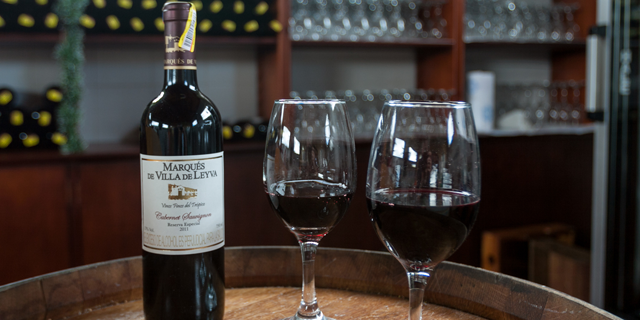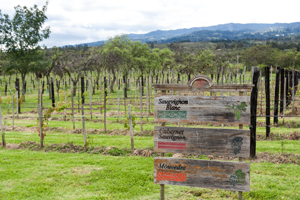As I traveled down a short, dusty, bumpy country road the greenhouses full of tomatoes suddenly gave way to grape vines. Cabernet Sauvignon vines, to be precise. From France. I pulled into a driveway and found myself surrounded by rolling hills covered in vines. Beyond the parking lot was a lovely picnic area with umbrella-covered tables and next to that a welcoming tasting room.
I could have been in my hometown of Paso Robles in Central California wine country. Instead, I was in the Colombian Andes, just a few hours from Bogota, visiting Marques de Villa de Leyva winery, one of only two serious wineries in the country. Tours, in Spanish, and tastings are available by appointment Monday through Saturday between 10 am and 5 pm.
Okay, I thought, so the owners of this 25-year-old operation got the trimmings right, but what about the wine?
Marques de Villa de Leyva owner Don Pablo Toro earned a degree in enology from the University of California Davis, one of the world’s most respected enological schools, before setting up shop. He is now making international-award-winning wines that were as exciting, balanced, elegant and tasty as many of the wines from my Paso Robles wine country home.
The 2013 Sauvignon Blanc ($19) had a dry, light start with a burst of citrus and melon at the finish. It was completely refreshing and drinkable as a SB should be. The succulent 2011 Cabernet Sauvignon Reserve Especial ($24), aged in French oak for 18 months, had butter and blackberry on the nose and added smoke and pepper jam on the tongue. The Cabernet Sauvignon Reserve ($17), aged for six months in California oak, and the Cabernet Sauvignon Grand Reserve ($22), aged for 12 months in California oak, were also delicious and good values as well. The winery’s award-winning dry rose ($17) was, unfortunately, sold out.
The 23 acre Marques de Villa de Leyva vineyard, which includes a small experimental patch with merlot, viognier, malbec, mouvedre and more, is located at nearly 7,000 feet and just a few degrees north of the equator. Daily temperature fluxuations between 42 and 78 degrees and the pH neutral soil, high in calcium and potassium carbonates, are perfect for growing grapes. The strong equatorial sun also means that Don Pablo harvests a crop (by hand) every eight months instead of just once a year as is normal in the rest of the grape growing world. However, he gets smaller yields–just 4 tons of grapes per acre versus around 15 tons per acre from vineyards in Chile or Argentina.
Still, the winery manages to produce 25,000 bottles a year which are sold through the tasting room (where you can take advantage of a 20% discount on six bottles or more) and at select restaurants and retailers in Bogota. They hope to get distribution into Medellin soon.
Insider tip: plan your route to Marques de Villa de Leyva Winery via the nearby town of Sutamarchán which is famous for its sausages. Stop at any of the roadside restaurants and pick up a sampler plate at to go including tasty bites of morcillo (rice-filled blood sausage), chorizo, longaniza, and grilled pork morsels for a DIY picnic at the winery.
And if you’re visiting the Boyaca region of Colombia make time to visit Marques Puntalarga Winery as well. The wines produced here (mostly vintage-less pinot noirs and rieslings) are not nearly as nuanced and polished as the wines from Marques de Villa de Leyva, however, at over 8,400 feet Puntalarga has some of the highest vineyards in the world and their tasting patio has epic valley views. There’s no sign. Just turn onto the shabby paved road that heads up a small hill near the kilometer 7 marker on the highway between Sogamoso and Nobsa.



![Making Mealtime Matter with La Familia: Easy Sofrito [Video]](https://thelatinkitchen.com/wp-content/uploads/2015/10/sofrito-shutterstock__0-500x383.jpg)
![Easy Latin Smoothies: Goji Berry Smoothie [Video]](https://thelatinkitchen.com/wp-content/uploads/2015/12/goji_berry-shutterstock_-500x383.jpg)
















![Fun and Fast Recipes: Fiesta Cabbage Salad [Video]](https://thelatinkitchen.com/wp-content/uploads/2015/11/fiesta_cabbage_slaw-shutterstock_-500x383.jpg)









